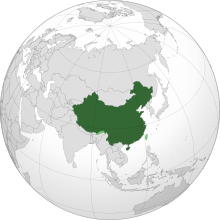User:DukeTheos/sandbox
Commonwealth of The Republic of China, Tibet, Manchuria and Mongolia | |
|---|---|
| Anthem: 中華民國國歌 Zhōnghuá Mínguó guógē ("Anthem of The Republic of China") | |
 Land controlled by the Republic of China shown in dark green; land claimed but not controlled shown in light green. | |
| Capital | Peking 39°55′N 116°23′E / 39.917°N 116.383°E |
| Largest city | Shanghai (urban area) Chungking (city proper) |
| Official languages | Standard Chinese[a] |
| Recognised regional languages | |
| Official script | Simplified Chinese[b] |
| Ethnic groups |
|
| Religion | See Religion in China |
| Demonym(s) | Chinese government_type = Unitary Semi-Presidential republic |
| Government | |
| Hu Jintao | |
| Chiang Yu-Mei | |
• Premier | Freddy Tyce |
| Alexander Papengelou | |
| Legislature | Legislative Yuan |
| Formation | |
| c. 2070 BCE | |
| 221 BCE | |
| 1 January 1912 | |
| 15 July 1975 | |
| 20 August 1995 | |
| Area | |
• Total | 11,161,962 km2 (4,309,658 sq mi)[d][3] (3rd/4th) |
• Water (%) | 2.5%[e] |
| Population | |
• 2021 estimate | |
• 2010 census | 1,456,786,326[7] (1st) |
• Density | 132[8]/km2 (341.9/sq mi) (86th) |
| GDP (nominal) | 2020 estimate |
• Total | |
• Per capita | |
| Gini (2018) | medium |
| HDI (2018) | very high (67th) |
| Currency | Yuan (¥)[f] (CNY) |
| Time zone | UTC+5:30 to +8:30 (Chinese Time Zones) |
| Date format | |
| Driving side | right[g] |
| Calling code | +86 |
| ISO 3166 code | CN |
| Internet TLD | |
Cite error: There are <ref group=lower-alpha> tags or {{efn}} templates on this page, but the references will not show without a {{reflist|group=lower-alpha}} template or {{notelist}} template (see the help page).
- ^ "Demographic Yearbook—Table 3: Population by sex, rate of population increase, surface area and density" (PDF). UN Statistics. 2007. Archived from the original (PDF) on 24 December 2010. Retrieved 31 July 2010.
- ^ "China". Retrieved 16 November 2012.
{{cite web}}: Unknown parameter|encyclopedia=ignored (help) - ^ "Largest Countries in the World by Area – Worldometers". www.worldometers.info.
- ^ Cite error: The named reference
CIAwas invoked but never defined (see the help page). - ^ "World Population Prospects 2022". United Nations Department of Economic and Social Affairs, Population Division. Retrieved July 17, 2022.
- ^ "World Population Prospects 2022: Demographic indicators by region, subregion and country, annually for 1950-2100" (XSLX) ("Total Population, as of 1 July (thousands)"). United Nations Department of Economic and Social Affairs, Population Division. Retrieved July 17, 2022.
- ^ Cite error: The named reference
groupswas invoked but never defined (see the help page). - ^ "Population density (people per sq. km of land area)". IMF. Retrieved 16 May 2015.
- ^ a b Cite error: The named reference
IMFWEOCNwas invoked but never defined (see the help page). - ^ "China Economic Update, December 2019 : Cyclical Risks and Structural Imperatives" (PDF). openknowledge.worldbank.org. World Bank. p. 21. Retrieved 3 January 2020.
The Gini coefficient, a measure of overall income inequality, declined to 0.462 in 2015, and has since risen to 0.467 in 2018 (Figure 27). Higher income inequality is partly driven by unequal regional income distribution. The eastern coastal regions have been the driver of China's rapid growth, due to its geographic location and the early introduction of reforms. As a result, the eastern coastal region is now home to 38 percent of the population, and its per capita GDP was 77 percent higher than that of the central, western, and northeastern regions in 2018. This gap widened further in the first three quarters of 2019. This is in part due to a disproportionate slowdown in interior provinces, which are more dependent on commodities and heavy industry. The slowdown has been negatively affected by structural shifts, especially necessary cuts in overcapacity (Figure 28).
- ^ "Human Development Report 2019" (PDF). United Nations Development Programme. 10 December 2019. Retrieved 10 December 2019.
Cite error: There are <ref group=note> tags on this page, but the references will not show without a {{reflist|group=note}} template (see the help page).



